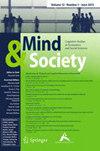2019冠状病毒病期间尼泊尔青年人群焦虑、抑郁和压力的流行:一项横断面研究
Q1 Arts and Humanities
引用次数: 0
摘要
新型冠状病毒对全球公众的身体健康和心理健康产生了前所未有的影响。在冠状病毒病(COVID-19)大流行期间,年轻人容易受到负面心理影响。本研究旨在确定2019冠状病毒病大流行期间尼泊尔年轻人中焦虑、抑郁和压力的患病率。此外,它旨在研究焦虑、抑郁和压力的社会人口学预测因素。通过在线平台进行定量横断面调查。在2020年10月5日至2020年12月5日期间,年龄在16- 40岁之间的301名参与者填写了经过验证的焦虑、抑郁和压力量表(ADSS)。在我们的研究人群中,焦虑、抑郁和压力的总患病率分别为46.5%、50.6%和56.2%。焦虑、抑郁和压力在16-24岁年龄组、女性、农村人口和本科学历受访者中均占主导地位。此外,在部落民族、已婚妇女和有感知缺陷的受访者中,抑郁症的发生率更高。二元logistic回归分析显示,女性(优势比(OR)=1.64;95% CI: 0.99-2.17)和本科教育水平(OR=4.246;95% CI: 1.44-12.53)与焦虑独立相关;部落族裔受访者(OR=2.22;95% CI: 1.31-3.74)显示16-24岁年龄组抑郁症发生率较高(OR=0.34;95% CI: 0.12-0.95)发现压力水平增加。尼泊尔青年人口表现出高度的焦虑、抑郁和压力。这些发现表明,迫切需要心理支持项目来促进尼泊尔青年的心理健康。此外,未来的纵向研究应以足够的样本量进行,以探索COVID-19对青年人群的长期心理健康影响。本文章由计算机程序翻译,如有差异,请以英文原文为准。
Prevalence of Anxiety, Depression, and Stress among Nepalese Youth Population during COVID-19: A Cross-Sectional Study
The novel coronavirus presentsan unprecedented impact on physical as well as global public mental health. Younger people are vulnerable to negative psychological consequences during the Coronavirus disease (COVID-19) pandemic. This study aimed to identify the prevalence of anxiety, depression, and stress among the younger Nepalese population during the COVID-19 pandemic.Furthermore, it aimed to examine sociodemographic predictors of anxiety, depression, and stress. A quantitative cross-sectional survey was conducted through online platforms. Three hundred-one (301) participants of age group 16- 40 years filled the validated Anxiety, Depression, and Stress Scale (ADSS) form between 5th October 2020 to 5th December 2020.The total prevalence of anxiety, depression, and stress in our study population was 46.5%, 50.6%, and 56.2%, respectively. Anxiety, depression, and stress all were predominant among the age group of 16-24 years, female population, those living in rural areas, and respondents with undergraduate education levels. Moreover, depression was found to be higher among tribal ethnicity, married women, and respondents with the perceived defect. Binary logistic regression analysis showed females (odds ratio (OR)=1.64; 95% CI: 0.99-2.17) and undergraduate educationlevels(OR=4.246; 95% CI: 1.44-12.53) were independently associated with anxiety; tribal ethnicity respondents (OR=2.22; 95% CI: 1.31-3.74) showed higher rate of depression and the age group 16-24 years (OR=0.34; 95% CI: 0.12-0.95) were found to have increased stress level. The Nepalese youth population showed a high prevalence of anxiety, depression, and stress. These findings suggest that psychological support programs are needed urgently to promote the psychological well-being of Nepalese youth. Also, future longitudinal studies should be conducted with an adequate sample size to explore the long-term mental health impact of COVID-19 among the youth population.
求助全文
通过发布文献求助,成功后即可免费获取论文全文。
去求助
来源期刊

Mind and Society
Arts and Humanities-Philosophy
CiteScore
2.30
自引率
0.00%
发文量
5
期刊介绍:
Mind & Society is a journal for ideas, explorations, investigations and discussions on the interaction between the human mind and the societal environments. Scholars from all fields of inquiry who entertain and examine various aspects of these interactions are warmly invited to submit their work. The journal welcomes case studies, theoretical analysis and modeling, data analysis and reports (quantitative and qualitative) that can offer insight into existing frameworks or offer views and reason for the promise of new directions for the study of interaction between the mind and the society. The potential contributors are particularly encouraged to carefully consider the impact of their work on societal functions in private and public sectors, and to dedicate part of their discussion to an explicit clarification of such, existing or potential, implications.Officially cited as: Mind Soc
 求助内容:
求助内容: 应助结果提醒方式:
应助结果提醒方式:


